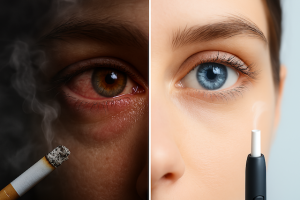For the first time, CoEHAR researches reported a case of urticaria following the inhalation of a specific flavoring in an e-liquid used during a switching trial. Although linked to a specific component of the liquid used, this finding highlight the need of further regulation of e-liquid.
Electronic cigarettes are an increasingly popular tools for tobacco substitution worldwide. Although data from hundreds of international independent studies confirm that electronic cigarettes are notably less harmful than traditional tobacco cigarettes, it’s important to acknowledge that they may still pose potential health risks, some of which have not been fully identified as of yet.
CoEHAR researches reported the case of a 24-year-old male smoker from Chisinau (Moldova Republic), who developed urticaria lesions after the use of ecig during a switching trial conducted in January 2022. It was a mild-moderate form of urticaria with only skin manifestation (generalized itchy rush) and no breathing difficulty. After 20 days of using electronic cigarette with a specific e-liquid, he developed hives on face, neck, arms and legs. He stopped vaping and symptoms waned completely within few days. A few days after restarting the trial, symptoms reappeared and he was forced to stop vaping completely. After the last cessation, symptoms were no longer detectable.
“In specific individuals with susceptibility, the inhalation of certain flavorings present in ECs can lead to generalized urticaria (condition characterized by skin hives and itching due to sensitization) – explains prof. Riccardo Polosa, CoEHAR Founder – This is the first reported case of urticaria associated with vaping products: although a rare event, we advocate for enhanced regulation of e-liquids, the substances used in ECs, to mitigate the potential for adverse health effects associated with their use”
To help the patient stay smoke free, he was shifted to a heated tobacco products: to date, no recurrence of urticaria or side effects was reported again. CoEHAR scientists speculated that urticaria occurred owing to some chemical components present in the formula of the liquid used. The exclusion of several components of the e-liquid used during the study, such as nickel and nicotine, led researchers to discover that a key flavoring present in the liquid was oakmoss, a lichen that provides musky and woody scents.
Its use in perfumery has been recently banned owing to concerns that caused skin rashes in up to 3% of the EU population. Exposure to Oakmoss can cause immediate allergy, contact urticaria, rhinitis and asthma in sensitized people. Sensitization experiments in rodents have shown that Oakmoss and its main allergens are potent sensitizers. It is rarely present in e-liquids. Skin-prick testing in formulation containing oak moss were positive thus confirming the role of this fragrance in the urticaria reported case.
More information
Here is the link to “Generalized urticaria following the use of e-cigarette: a case reported during a switching trial“:




